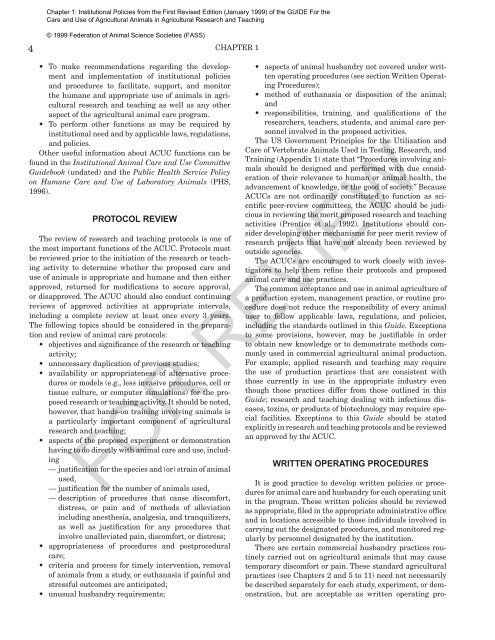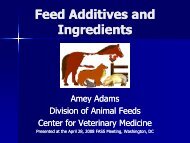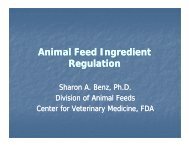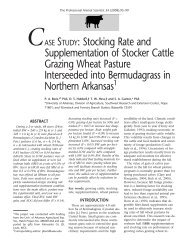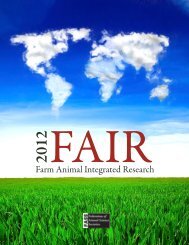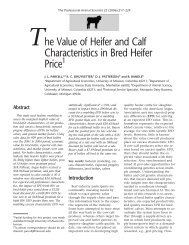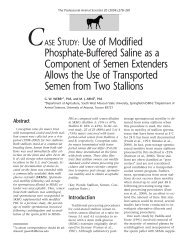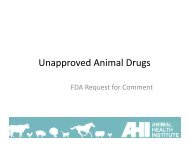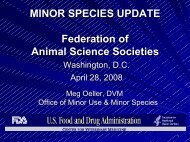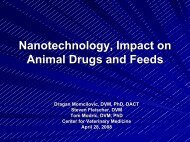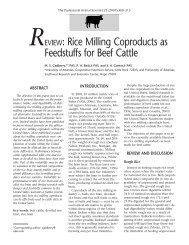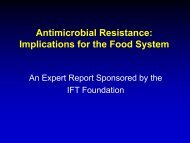GUIDE For the Care and Use of Agricultural Animals in Agricultural ...
GUIDE For the Care and Use of Agricultural Animals in Agricultural ...
GUIDE For the Care and Use of Agricultural Animals in Agricultural ...
You also want an ePaper? Increase the reach of your titles
YUMPU automatically turns print PDFs into web optimized ePapers that Google loves.
Chapter 1: Institutional Policies from <strong>the</strong> First Revised Edition (January 1999) <strong>of</strong> <strong>the</strong> <strong>GUIDE</strong> <strong>For</strong> <strong>the</strong><br />
<strong>Care</strong> <strong>and</strong> <strong>Use</strong> <strong>of</strong> <strong>Agricultural</strong> <strong>Animals</strong> <strong>in</strong> <strong>Agricultural</strong> Research <strong>and</strong> Teach<strong>in</strong>g<br />
4<br />
© 1999 Federation <strong>of</strong> Animal Science Societies (FASS)<br />
CHAPTER 1<br />
• To make recommendations regard<strong>in</strong>g <strong>the</strong> development<br />
<strong>and</strong> implementation <strong>of</strong> <strong>in</strong>stitutional policies<br />
<strong>and</strong> procedures to facilitate, support, <strong>and</strong> monitor<br />
<strong>the</strong> humane <strong>and</strong> appropriate use <strong>of</strong> animals <strong>in</strong> agricultural<br />
research <strong>and</strong> teach<strong>in</strong>g as well as any o<strong>the</strong>r<br />
aspect <strong>of</strong> <strong>the</strong> agricultural animal care program.<br />
• To perform o<strong>the</strong>r functions as may be required by<br />
<strong>in</strong>stitutional need <strong>and</strong> by applicable laws, regulations,<br />
<strong>and</strong> policies.<br />
O<strong>the</strong>r useful <strong>in</strong>formation about ACUC functions can be<br />
found <strong>in</strong> <strong>the</strong> Institutional Animal <strong>Care</strong> <strong>and</strong> <strong>Use</strong> Committee<br />
Guidebook (undated) <strong>and</strong> <strong>the</strong> Public Health Service Policy<br />
on Humane <strong>Care</strong> <strong>and</strong> <strong>Use</strong> <strong>of</strong> Laboratory <strong>Animals</strong> (PHS,<br />
1996).<br />
PROTOCOL REVIEW<br />
The review <strong>of</strong> research <strong>and</strong> teach<strong>in</strong>g protocols is one <strong>of</strong><br />
<strong>the</strong> most important functions <strong>of</strong> <strong>the</strong> ACUC. Protocols must<br />
be reviewed prior to <strong>the</strong> <strong>in</strong>itiation <strong>of</strong> <strong>the</strong> research or teach<strong>in</strong>g<br />
activity to determ<strong>in</strong>e whe<strong>the</strong>r <strong>the</strong> proposed care <strong>and</strong><br />
use <strong>of</strong> animals is appropriate <strong>and</strong> humane <strong>and</strong> <strong>the</strong>n ei<strong>the</strong>r<br />
approved, returned for modifications to secure approval,<br />
or disapproved. The ACUC should also conduct cont<strong>in</strong>u<strong>in</strong>g<br />
reviews <strong>of</strong> approved activities at appropriate <strong>in</strong>tervals,<br />
<strong>in</strong>clud<strong>in</strong>g a complete review at least once every 3 years.<br />
The follow<strong>in</strong>g topics should be considered <strong>in</strong> <strong>the</strong> preparation<br />
<strong>and</strong> review <strong>of</strong> animal care protocols:<br />
• objectives <strong>and</strong> significance <strong>of</strong> <strong>the</strong> research or teach<strong>in</strong>g<br />
activity;<br />
• unnecessary duplication <strong>of</strong> previous studies;<br />
• availability or appropriateness <strong>of</strong> alternative procedures<br />
or models (e.g., less <strong>in</strong>vasive procedures, cell or<br />
tissue culture, or computer simulations) for <strong>the</strong> proposed<br />
research or teach<strong>in</strong>g activity. It should be noted,<br />
however, that h<strong>and</strong>s-on tra<strong>in</strong><strong>in</strong>g <strong>in</strong>volv<strong>in</strong>g animals is<br />
a particularly important component <strong>of</strong> agricultural<br />
research <strong>and</strong> teach<strong>in</strong>g;<br />
• aspects <strong>of</strong> <strong>the</strong> proposed experiment or demonstration<br />
hav<strong>in</strong>g to do directly with animal care <strong>and</strong> use, <strong>in</strong>clud<strong>in</strong>g<br />
— justification for <strong>the</strong> species <strong>and</strong> (or) stra<strong>in</strong> <strong>of</strong> animal<br />
used,<br />
— justification for <strong>the</strong> number <strong>of</strong> animals used,<br />
— description <strong>of</strong> procedures that cause discomfort,<br />
distress, or pa<strong>in</strong> <strong>and</strong> <strong>of</strong> methods <strong>of</strong> alleviation<br />
<strong>in</strong>clud<strong>in</strong>g anes<strong>the</strong>sia, analgesia, <strong>and</strong> tranquilizers,<br />
as well as justification for any procedures that<br />
<strong>in</strong>volve unalleviated pa<strong>in</strong>, discomfort, or distress;<br />
• appropriateness <strong>of</strong> procedures <strong>and</strong> postprocedural<br />
care;<br />
• criteria <strong>and</strong> process for timely <strong>in</strong>tervention, removal<br />
<strong>of</strong> animals from a study, or euthanasia if pa<strong>in</strong>ful <strong>and</strong><br />
stressful outcomes are anticipated;<br />
• unusual husb<strong>and</strong>ry requirements;<br />
• aspects <strong>of</strong> animal husb<strong>and</strong>ry not covered under written<br />
operat<strong>in</strong>g procedures (see section Written Operat<strong>in</strong>g<br />
Procedures);<br />
• method <strong>of</strong> euthanasia or disposition <strong>of</strong> <strong>the</strong> animal;<br />
<strong>and</strong><br />
• responsibilities, tra<strong>in</strong><strong>in</strong>g, <strong>and</strong> qualifications <strong>of</strong> <strong>the</strong><br />
researchers, teachers, students, <strong>and</strong> animal care personnel<br />
<strong>in</strong>volved <strong>in</strong> <strong>the</strong> proposed activities.<br />
The US Government Pr<strong>in</strong>ciples for <strong>the</strong> Utilization <strong>and</strong><br />
<strong>Care</strong> <strong>of</strong> Vertebrate <strong>Animals</strong> <strong>Use</strong>d <strong>in</strong> Test<strong>in</strong>g, Research, <strong>and</strong><br />
Tra<strong>in</strong><strong>in</strong>g (Appendix 1) state that “Procedures <strong>in</strong>volv<strong>in</strong>g animals<br />
should be designed <strong>and</strong> performed with due consideration<br />
<strong>of</strong> <strong>the</strong>ir relevance to human or animal health, <strong>the</strong><br />
advancement <strong>of</strong> knowledge, or <strong>the</strong> good <strong>of</strong> society.” Because<br />
ACUCs are not ord<strong>in</strong>arily constituted to function as scientific<br />
peer-review committees, <strong>the</strong> ACUC should be judicious<br />
<strong>in</strong> review<strong>in</strong>g <strong>the</strong> merit proposed research <strong>and</strong> teach<strong>in</strong>g<br />
activities (Prentice et al., 1992). Institutions should consider<br />
develop<strong>in</strong>g o<strong>the</strong>r mechanisms for peer merit review <strong>of</strong><br />
research projects that have not already been reviewed by<br />
outside agencies.<br />
The ACUCs are encouraged to work closely with <strong>in</strong>vestigators<br />
to help <strong>the</strong>m ref<strong>in</strong>e <strong>the</strong>ir protocols <strong>and</strong> proposed<br />
animal care <strong>and</strong> use practices.<br />
The common acceptance <strong>and</strong> use <strong>in</strong> animal agriculture <strong>of</strong><br />
a production system, management practice, or rout<strong>in</strong>e procedure<br />
does not reduce <strong>the</strong> responsibility <strong>of</strong> every animal<br />
user to follow applicable laws, regulations, <strong>and</strong> policies,<br />
<strong>in</strong>clud<strong>in</strong>g <strong>the</strong> st<strong>and</strong>ards outl<strong>in</strong>ed <strong>in</strong> this Guide. Exceptions<br />
to some provisions, however, may be justifiable <strong>in</strong> order<br />
to obta<strong>in</strong> new knowledge or to demonstrate methods commonly<br />
used <strong>in</strong> commercial agricultural animal production.<br />
<strong>For</strong> example, applied research <strong>and</strong> teach<strong>in</strong>g may require<br />
<strong>the</strong> use <strong>of</strong> production practices that are consistent with<br />
those currently <strong>in</strong> use <strong>in</strong> <strong>the</strong> appropriate <strong>in</strong>dustry even<br />
though those practices differ from those outl<strong>in</strong>ed <strong>in</strong> this<br />
Guide; research <strong>and</strong> teach<strong>in</strong>g deal<strong>in</strong>g with <strong>in</strong>fectious diseases,<br />
tox<strong>in</strong>s, or products <strong>of</strong> biotechnology may require special<br />
facilities. Exceptions to this Guide should be stated<br />
explicitly <strong>in</strong> research <strong>and</strong> teach<strong>in</strong>g protocols <strong>and</strong> be reviewed<br />
an approved by <strong>the</strong> ACUC.<br />
FOR REVIEW<br />
WRITTEN OPERATING PROCEDURES<br />
It is good practice to develop written policies or procedures<br />
for animal care <strong>and</strong> husb<strong>and</strong>ry for each operat<strong>in</strong>g unit<br />
<strong>in</strong> <strong>the</strong> program. These written policies should be reviewed<br />
as appropriate, filed <strong>in</strong> <strong>the</strong> appropriate adm<strong>in</strong>istrative <strong>of</strong>fice<br />
<strong>and</strong> <strong>in</strong> locations accessible to those <strong>in</strong>dividuals <strong>in</strong>volved <strong>in</strong><br />
carry<strong>in</strong>g out <strong>the</strong> designated procedures, <strong>and</strong> monitored regularly<br />
by personnel designated by <strong>the</strong> <strong>in</strong>stitution.<br />
There are certa<strong>in</strong> commercial husb<strong>and</strong>ry practices rout<strong>in</strong>ely<br />
carried out on agricultural animals that may cause<br />
temporary discomfort or pa<strong>in</strong>. These st<strong>and</strong>ard agricultural<br />
practices (see Chapters 2 <strong>and</strong> 5 to 11) need not necessarily<br />
be described separately for each study, experiment, or demonstration,<br />
but are acceptable as written operat<strong>in</strong>g pro-


